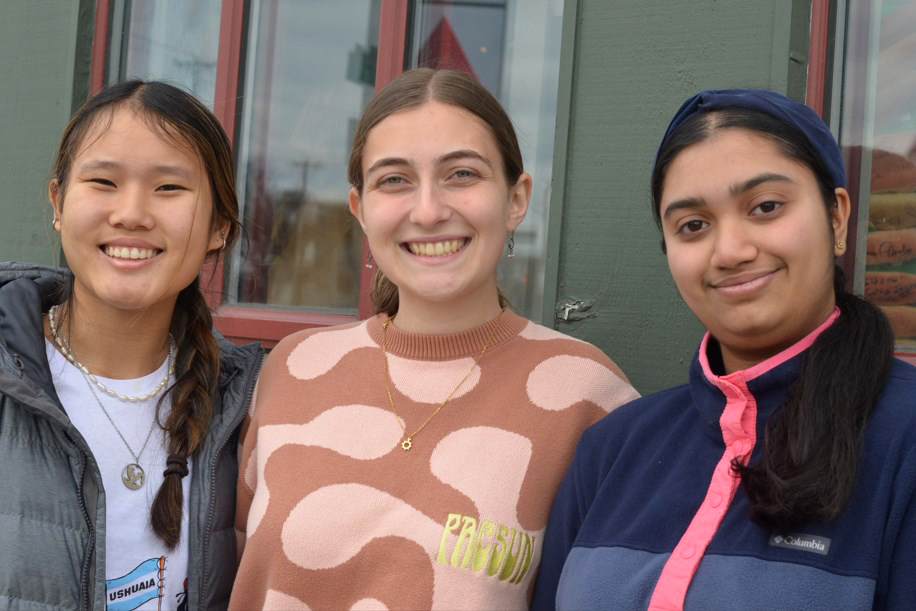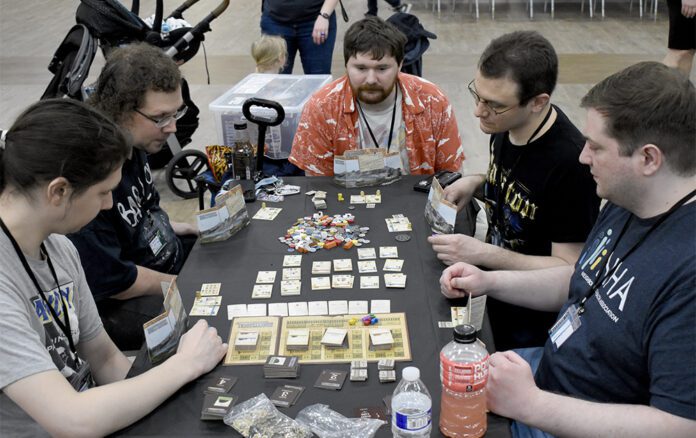Millions of birds killed to fight bird flu

OHIO – According to the Centers for Disease Control, Ohio currently has the highest number of avian flu cases in the U.S.
As one of the top three egg-producing states, along with Iowa and Indiana, the outbreak has had a detrimental impact on Ohio’s poultry industry. Since December, nearly 15 million birds across Ohio have been killed to stop the spread of the disease.

When I was a 12-year-old living on a small farm, one of my jobs was to kill one of our chickens for Sunday dinner. They had the run of the place, so catching them was challenging. It wasn’t pleasant, but it was a regular part of life for a country boy. Humans kill animals for food.
To me, chickens were very interesting. I remember them being smart with individual personalities – some were quiet and laid back, while others were outgoing and feisty. Most people think of them as just being dumb birds to turn in to McNuggets and wings. I know better.
Chickens are a mainstay of American life, but the way we raise them now is a far cry from how my family (and many other families) did when I was young. Raising them on factory farms may be increasing susceptibility to diseases, such as bird flu.
Today’s mega factory farm, which is common in the industry, often raises more than 500,000 chickens per year. These farms usually have multiple broiler houses. A broiler is a chicken raised for meat, and most of them are killed when they are 5-7 weeks old.
Each house holds between 20,000 and 40,000 chickens, each occupying approximately .8 to 1.0 square feet of space.
According to the Ohio Poultry Association, Ohio is the No. 2 egg farming state in the U.S. and produces 10 billion eggs each year; Ohio chicken farms produce 554+ million pounds of chicken annually; and Ohio ranks 9th in the nation for turkey farming.
Avian flu outbreak
In February, Ohio confirmed its first human case of bird flu. The individual, who worked at a farm in Mercer County and had contact with infected birds, tested positive for the virus.
According to the CDC, cases of bird flu in humans in the United States caused by the Avian Influenza A(H5) virus have mostly been mild. Infections mainly occur in people who work closely with sick or infected animals. Symptoms are variable, but often include eye redness, fever and respiratory issues. Serious illness caused by this virus is possible, so continued prevention and monitoring are needed.
In an interview on News 5 Cleveland, Dr. Erika Sobolewski, Summit County’s public health medical director, stated that “sure, the bird flu news is always concerning, but really, it’s a low risk to the average Ohioan. At this point in time, the people who should really be cautious are any of those people who work with poultry, particularly anyone who has sick or dead poultry or even wild birds. Those are the people who should really be taking precautions.”

Speaking for herself and not for the University of Toledo, Dr. Joan Duggan, a UToledo professor of medicine specializing in infectious diseases, said the current state of avian flu “is something we’ve been worried about since the late 1990s, when we first started to see this specific strain start to move through the avian population. We have been getting ready for it over the last 20 years, with some vaccines, with some strategies, and considering different medications.”
So, the current state of play with avian influenza is that we’re seeing outbreaks, not unheard of before, but we’re seeing outbreaks with both migratory birds and domesticated birds, that spill over into the mammal world – cows specifically – and that’s what gets everybody very nervous, because, as we have everybody in close contact together, cows, chickens, humans, everybody’s mixing viruses back and forth.
Dr. Joan Duggan
One worry is that the bird flu viruses will continue evolving so that they will be able to infect many more animals beyond their natural reservoir in wild birds. The bird flu has already moved from wild birds into domestic poultry, pigs, cats and dogs, and wild mammals, including seals and humans. At present, while humans can be infected, the bird flu does not appear to be transmitted between humans.

Bird flu has also killed house cats, raccoons, skunks, seals, leopards, and several other mammals. In the United States, there have been 67 confirmed human cases of H5N1 bird flu since 2022, with the first death reported in January 2025. The risk to the general public presently remains low due to the lack of person-to-person transmission.
There is a controversy about the possibility that housing 20,000 to 40,000 birds in close quarters might make it easier for the avian flu virus to mutate, potentially becoming more problematic for humans.
Some of the proponents of the present system say that since the birds are housed inside, the risk of them catching the avian flu is minimal. Those on the other side of the debate say that the conditions in factory farms can, in fact, potentially lead to concerning viral mutations. They also say that while birds are housed inside, workers can bring the avian virus inside on clothing, footwear, machinery and contaminated feed.
As stated earlier, to date, the disease is not presently transferable from human to human, and only one death has been reported in the United States.
If you find a dead bird you suspect might have avian flu, Mike Reynolds, with the Ohio Department of Natural Resources, offered some advice.
“The public needs to know that we really need you to stay away from sick or dying wildlife. Call the experts. Call the Ohio Division of Wildlife. We’ll tell you what to do,” he said.
“And if you have kids or pets, and you really need to get the dead animals out of the area, we’re going to have you wear personal protective equipment, like rubber gloves and an N95 mask or goggles, or a face shield, and put those birds in a double bag and dispose of them properly.”
For information on backyard flocks, go here.
The Division of Wildlife asks people to call 1-800-WILDLIFE (1-800-945-3543) and report sightings of dead birds in groups of more than six.
UT Bash hosts 39th annual BASHCon
TOLEDO – The gaming community was in for a treat this past weekend when the University of Toledo campus unleashed BASHCon. UT Bash, a student organization, hosted the 39th annual event at the Lancelot Thompson Student Union.
Most of the event was in the auditorium on the third floor of the Student Union. Visitors could purchase art, board games, shirts and accessories for role-playing games, such as Dungeons and Dragons. Guests could also choose from several board games to play at a table.
Attendees played arcade games on the second floor. There were also more active events, such as Belagarth, where participants could join a live combat simulation to experience what dueling was like in medieval times.

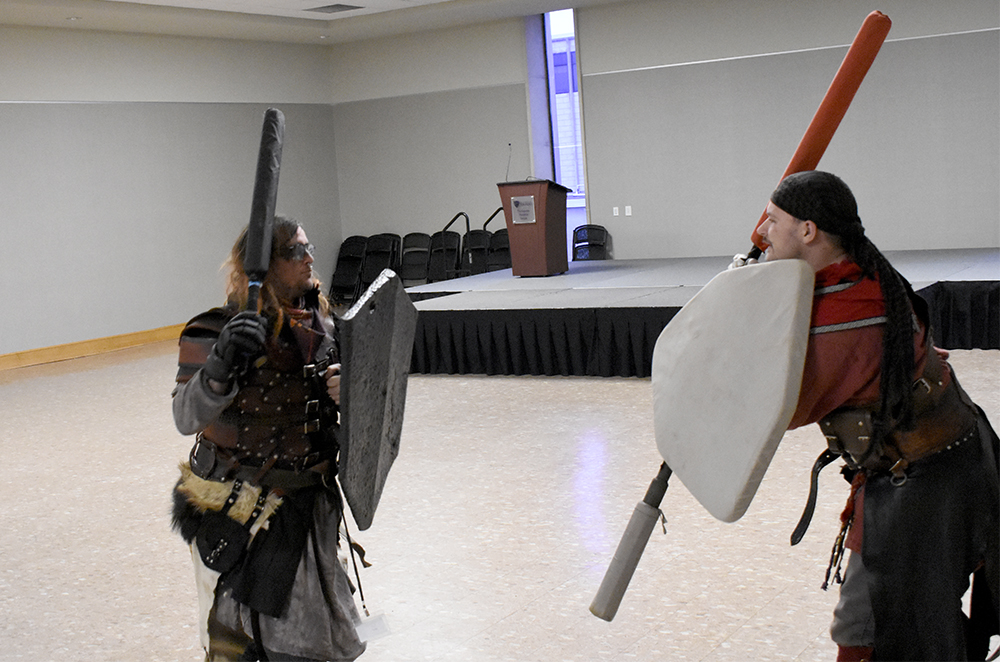
Bryan and Ian engage in a duel hosted by Belegarth Medieval Combat Society. (TFP Photo/Raymond Bieber)
Board games could be bought and sold through the annual bazaar, an auction-style event where anyone could bring a board game they wish to part ways with.
About 450 visitors attended the event, including 17 vendors and four vendors.
Christian Pieri, BASHCon lead coordinator, said Toledo BASHCon started in 1986, one year after the student organization began.
“After a year of hanging out, playing tabletop RPG games like Dungeons and Dragons, everyone realized, ‘Hey, a lot of people like this. We should run an event for a bunch of people from all over to come attend, and they started Bashcon,’” said Pieri, who wants attendees to be part of the gaming community.
“The big thing I want people to take away from BashCon is the community that you can find,” he said. “We have all these open play tables set up so the people who’ve never talked before – never seen each other before – can sit down and just have fun, even though they don’t know each other.”
Pieri discussed how board games provide a more friendlier competition than sports.
“It’s a lot more ‘I am against my opponent,’ whereas you sit down at a table with three other people to play a game of Commander for Magic: The Gathering, and most of the time you all just end up having an entirely separate conversation away from the game,” explained Pieri. “While it still can be hyper competitive and there are tournaments and such for it, it’s also so easy to just sit down and play with your friends. It’s a great way to tell a story and get immersed in a world so different from our own.
“My pitch to someone who’s never been to Bashcon before would be if you’ve ever played a board game and had fun, if you’ve ever played a card game and had fun, you could attend Bashcon and at least find one thing you’ll enjoy with all of the vendors, from tabletop RPGs to Magic to figure fighting. We have everything [for] anyone who enjoys board games.”

To have a successful board game convention, there has to be reliable vendors selling board games. One vendor has been a reliable distributor of board games and accessories in Toledo for several years.
Ken Solo, owner and CEO of Checkmate Games and Hobbies, has been part of UT BASHCon since 1986, and Checkmate has been at the event for the last 14 years. He said the mission of Checkmate Games and Hobbies is to get kids away from screens and “interacting with other real live human beings face to face.
“A convention is just to get a whole bunch of people of similar interests to convene. Having a board game is great, but having someone else to play it with makes it worthwhile. We, as upright mammal human beings, need to interact with somebody else, and video gaming can only get you so far.”
Solo discussed the need for human interaction and how too much online gaming can lead to anxiety and depression. He also talked about the learning benefits board games can offer.
“We learn things like forward thinking strategy, or, even in the case of some kids who are playing Pokemon, just reading comprehension. Just doing basic math. Once you do play a card game long enough, you don’t need to pull out your pocket phone so you can use a calculator. You already know that math instantaneously because you do it in your head all the time as you’re playing games.”

One student there to pursue their interest in D&D and board games was Autumn Cerniak, a sophomore media communications major, who attended to visit a friend working at the event and for D&D. She said the role playing aspect draws her to the game.
“It’s really nice to have a space like this for people like me, and it’s nice to meet up with people to support local vendors. D&D is important to me, and D&D and other board games are very important to these people.
Cerniak also gave a pitch to people who have never attended.
“If they’re a student, I would just say, it’s free. But for someone who’s not a student, you can go check out a bunch of local vendors, play a bunch of board games with your friends. What more could you ask for?”

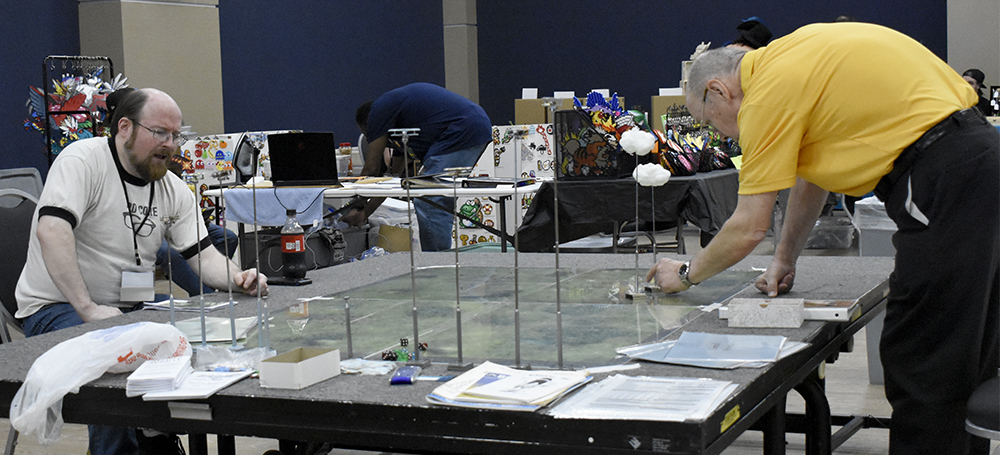
Toledoan Jamiya Neal goes to the Big Dance

TOLEDO – Jamiya Neal’s feet will never get stuck in cement.
The Toledo native, who helped Rogers’ boys basketball team reach the regional semifinals in 2020, has been, shall we say, on the move over the past several years.
Thursday night, in the first round of the NCAA Tournament, Neal and the ninth-seeded Creighton Bluejays (24-10) will take on eighth-seeded Louisville (27-7) in a South Region opener in Lexington, Ky.
Neal, a 6-foot-5 senior guard, is the only Creighton player to start all 34 games for coach Greg McDermott’s squad.

“I’m pretty excited,” Neal said. “I’m happy we get this opportunity to play another game with our teammates and my coaches. I want to try to extend my senior year as long as I can.”
This will be Neal’s third game playing in an NCAA Tournament game. He played in two NCAA games as a sophomore guard at Arizona State two years ago. He scored a career-high 16 points in the Sun Devils’ 98-73 win over Nevada at the University of Dayton that season.
“It was my first time playing close to home,” Neal said. “I had a lot of family and friends there.”
The Sun Devils lost to TCU, 72-70, on a last-second shot in their second NCAA game.
Neal spent his freshman and sophomore years at St. Francis de Sales High School, then transferred to Rogers for his junior season.
“I was ready to move on from that situation,” Neal said. “One of my best friends was going to Rogers and we knew all those guys at Rogers.”
Eighth-ranked Rogers was set to take a 22-3 record into the 2020 Division II regional semis against top-ranked Lima Shawnee when the Covid-19 pandemic forced officials to cancel the tournament.
“I’m grateful for Rogers and the opportunity to go there,” said Neal, who averaged 10.9 points, 7.4 rebounds and 3.5 assists per game in his lone season with the Rams. “I’m still a Ram for life. We had a good shot to win state. There were a lot of seniors on that team and they didn’t get to finish their season.”
Fearful that his senior season at Rogers might get canceled due to Covid, Neal transferred to Hillcrest Prep Academy in Gilbert, Ariz. for his final year of high school. He averaged 18 points, seven rebounds and five assists per game for the Bruins and still had to decide where to go to college.
“I was playing AAU ball that summer and [Arizona State’s staff] happened to be at one of the tournaments,” Neal said. “We had conversations, and then I went out [to ASU], toured it and decided to go there. It was what I needed; playing with other players who had Division 1 offers, playing against better competition. It got me better prepared had I stayed in Toledo. I’m so happy I made that decision.”
Neal still wasn’t done moving around. He learned about Creighton basketball and decided to transfer to the Omaha, Neb. campus to play for McDermott and the Bluejays.

“It just felt like the right fit,” Neal said. “I was searching for something and they had everything where I could grow as a basketball player and as a man. The weather [in Omaha] is kind of the same as Toledo, and it has a little bit of a Toledo feel. You get a big sense of community here, and I like that.”
McDermott, who has led Creighton to five straight NCAA Tournaments, said Neal “has been a breath of fresh air for our program.”
“He came here and has played every role we’ve asked him to play, and he’s become ‘us’ rather than forcing us to become ‘him,’” McDermott said. “That’s not easy when you’re in your last year of college basketball. He comes to work every day with a smile on his face and has really worked hard to get better.
“It’s been fun to watch him connect with his teammates. His assist numbers are as good as they’ve been at any time in his career. I think that’s a sign of trust in your teammates, when you’re willing to share the basketball like that. He understands that they’re going to share it with him as well.”
The Bluejays finished second behind sixth-ranked St. John’s in the Big East standings during the regular season. Creighton got past DePaul in double overtime and then beat two-time defending NCAA champion Connecticut, 71-62, in the Big East Tournament before falling to St. John’s in the championship game at Madison Square Garden in New York.
“I’ve never played at Madison Square Garden,” said Neal, who tied for the team lead with 19 points against UConn, and scored 13 against St. John’s. “It was kind of a surreal feeling. You hear it’s the best arena in the world, and you feel it when you go in.”
The Bluejays took a hit eight games into the season when junior guard Pop Isaacs underwent season-ending hip surgery. Isaacs scored 27 points in the Bluejays’ home win over top-ranked Kansas.
“We were still trying to figure out our identity and we were just finding our groove,” Neal said. “We beat Kansas, then we had to figure it out again. Everybody had to step up and do different things. Everybody had a role to step into and they were prepared to do it; they were capable of doing it. I think that’s why we’ve been so successful.”

Neal, who is majoring in business leadership, is averaging 11.5 points and 6.1 rebounds entering the NCAA Tournament. His 150 assists is second on the team, and he is shooting 44 percent from the field.
“He’s exceeded my expectations,” McDermott said. “He came into a very difficult situation. When Pop Isaacs went down with the injury, his role changed again and he had to play a bigger role on the team than what he was earlier in the season. He’s handled that with a lot of maturity.”
Announcements
(Announcements are compiled from press releases and in order received )
NEWS SHORTS BRIEFS ARE UPDATED DAILY
ANNOUNCEMENTS
TARTA approves new contract with ATU Local 697
TOLEDO – Amalgamated Transit Union Local 697 and the Toledo Area Regional Transit
Authority (TARTA) Board of Trustees have come to an agreement on a new 2 1/2-year
contract.
ATU – which represents more than 200 of TARTA’s employees – approved the
contract at a meeting March 18, and it was approved by the board March 20. The union’s membership includes TARTA fixed route, paratransit and TARTA Flex on-demand operators, in addition to mechanics and other personnel.
The agreement keeps pay and benefits for operators and maintenance employees in
line with transit industry standards and locally competitive with area jobs of the same
nature. This agreement – which takes effect May 1, 2025 and runs through December
31, 2027 – allows a raise of 11.5 percent over three years. Four percent increases will
be effective July 1of 2025 and 2026, and a 3.5 percent increase will take effect July 1,
2027.
The contract enables TARTA to create an operator apprenticeship program in
collaboration with the National and local ATU union. The apprenticeship program
utilizes an industry-proven curriculum to ensure operators have the skills needed for a
successful career in public transit.
This is in addition to the already established M-PACT mentorship program for newer
drivers, and would be the next step in TARTA’s increased commitment to training and
workforce development for its team members. (03/24)
Toledo Symphony announces Outstanding Music Educator Award
TOLEDO – The Toledo Symphony (TSO) has announced Matthew Shirey, Northwood Local
Schools Band director, as the recipient of the 2025 Outstanding Music Educator Award. This is the sixth consecutive year the TSO has honored current, full-time, K-12 music educators who teach music in public and private schools in the Northwest Ohio and Southeast Michigan region.
Matthew Shirey is currently in his 12th year of teaching and 7th year as the director of bands for Northwood Local Schools while being active as a leader in the music education community. Currently acting as the chair for the OMEA D1 High School Honor Band, the OMEA D1 Junior High S&E East location, while directing the BGSU Academy Band.
With these opportunities, Shirey is able to work with directors, undergraduate music education majors, and band students from all over Northwest Ohio. Shirey graduated Magna Cum Laude with his BM in Music Education from Wayne State University and MM in saxophone performance from Bowling Green State University.
Through the Outstanding Music Educator Award, the Toledo Symphony recognizes the vital role music teachers play in the lives of the students they teach. Music teachers introduce, instill and cultivate a love of music that surpasses the time spent in the classroom. They lay the foundation for a lifetime of appreciation that serves to perpetuate these art forms.
For more information about Toledo Symphony’s Outstanding Music Educator Award or
educational outreach opportunities for schools, please contact Ellie Lee at
elee@artstoledo.com or visit artstoledo.com/omeya. (03/23)
Old West End Association, Land Bank announce effort to revitalize former church in the heart of the neighborhood
TOLEDO – The Old West End Association and the Lucas County Land Bank announced their joint effort to revitalize the abandoned former Epworth United Methodist Church.
The organizations are seeking a redevelopment partner to transform the building into a mix of residential and commercial uses to benefit the neighborhood. A feasibility study developed by the Old West End Association and a dedicated website will be released publicly.
The iconic building, with over 34,000 usable square feet of space, has been a mainstay of the neighborhood for about 100 years, but it was abandoned more than 10 years ago
Speakers during a press conference on Friday were Laure Hammond, president of the Old West End Association, and David Mann, president & CEO of the Land Bank. Invited speakers included local elected officials, neighborhood residents and business owners, and Heritage Ohio. (03/21)

TPS NSTC program partners with University of Cincinnati
TOLEDO – Biology meets engineering through a new partnership between the Toledo Public School’s Natural Science Technology Center and the University of Cincinnati.
Through the National Science Foundation-funded Biology Meets Engineering (BME) program, this collaboration will provide students with unique learning experiences, scholarships and internship opportunities.
As part of the initiative, University of Cincinnati will offer a six-week paid internship program for high school students who have successfully completed a component of the BME curriculum, summer program or a UC college course. The program is designed to immerse students in cutting-edge research and engineering applications in the biological sciences.
UC will also host a professional development workshop for educators in July.
Representatives from NSTC and UC will be on hand, and there will be demonstrations of
robotics and biology projects, showcasing student and faculty collaboration in these fields. (3/18)
Schmucker’s sells out of pie on Pi Day
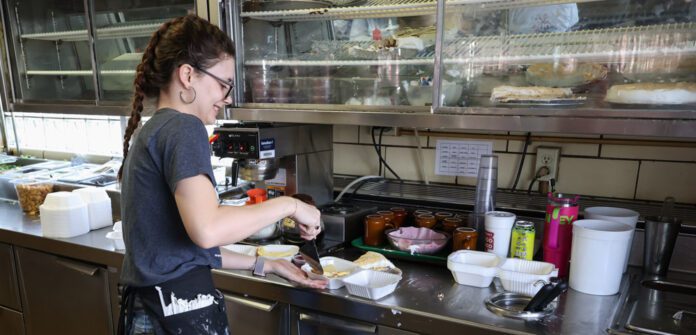
TOLEDO – Customers at Schmucker’s Restaurant made raising money for charity as easy as pie.
On March 14, also known as National Pi Day, $1 of every pie sale was donated to the Cherry Street Mission, regardless of whether customers bought a whole pie or just a slice.



It wasn’t by coincidence that the fundraiser took place on National Pi Day, which has occurred every March 14 since 1988, when physicist Larry Shaw, a staff member at the Exploratorium in San Francisco, linked the date March 14 (3/14) with the first three digits of pi (3.14).
Schmucker’s Restaurant owner Doug Schmucker said the fundraiser, going on for more than a decade, is a way to give back to the community.
“Our relationship with God is foundational to who we are,” he said. “We feel called to give back. This is our 77th year [in business] and we wouldn’t be at this place without the support of the community. And what better way to say thank you to the community than to give back to the community and give back to Cherry Street Mission?”
But Schmucker’s Restaurant was not the only business that gave back on Pi Day.
Savage and Associates, a financial advising company in Maumee, agreed to match Schmucker’s Restaurant’s donations dollar-for-dollar. Together, the businesses raised $5,000 ($2,500 + $2,500) for the mission this year.
This is the fifth year Savage Associates has supported the pi day event, which started after Schmucker asked his friend from the gym, Sean Savage, if he would like to participate.
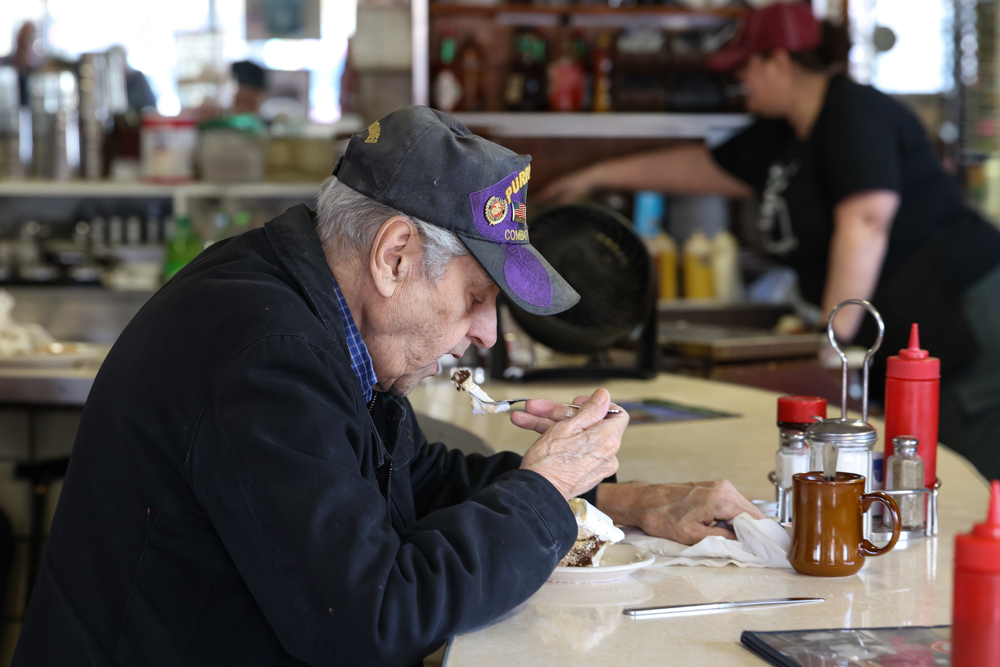
Cherry Street Mission offers a variety of services for members of the Toledo community. According to their website, “Cherry Street Mission endlessly seeks to eradicate poverty of the body, soul and spirit by connecting individuals to the resources they need, creating health and community sustainability.”
“Cherry Street Mission is in the work of bringing people up out of difficult situations, which in turn makes our community a better place,” Schmucker said.
Schmucker’s customer Dean Barton was one of many who came to support the fundraiser by purchasing pie with his meal.
“I support the Cherry Street Mission,” said Barton. “I know people who have been to the Cherry Street Mission. They come out sober.”
Barton said he planned to order two or three flavors of pie, deliberating between the cherry crumb, cheesecake and Dutch apple pies.
Schmucker said this is the first year they have held the fundraiser on National Pi Day, rather than National Pie Day, which is on January 23. While last year he said they had 100 pies leftover, this year they made more. They sold out by 4 p.m. and had to make more to keep up with all the orders.

Due to this year’s success, Schmucker said they will likely hold the fundraiser on Pi Day next year.
“I wanted to make it more impactful for Cherry Street. I mean, it’s not about Schmucker’s, right? Sure, it’s fun to eat pie. But it’s about Cherry Street and what they do for our community,” he said.
Pie/Pi Day is not the only fundraiser Schmucker’s Restaurant does, however.
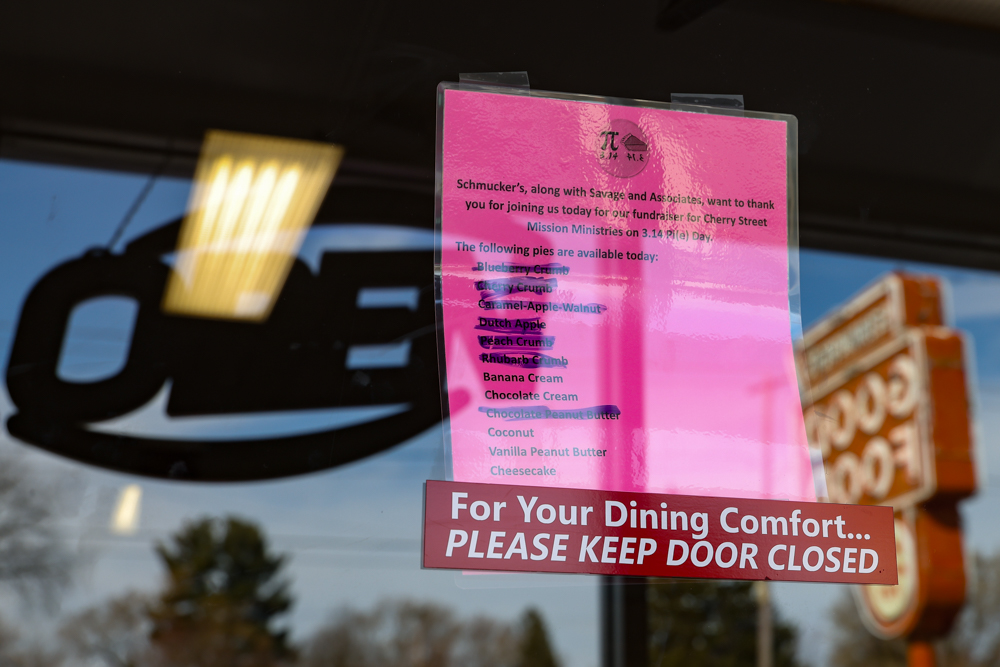
Schmucker said their other fundraisers have been for Sunshine Children’s Home, a facility which helps support children with medically complex needs. Their last fundraiser was during Schmucker’s Restaurant’s 75th year in business, where 75 percent of proceeds went to support Sunshine.
Schmucker said when Schmucker’s Restaurant reaches their 80th year in business, they plan to do a fundraiser where 80 percent of the proceeds go to Sunshine.
Though Schmucker said the restaurant has donated to other organizations, the Cherry Street Mission and Sunshine fundraisers are the most significant.
“Those are the two big ones that are near and dear to my heart,” Schmucker said.






